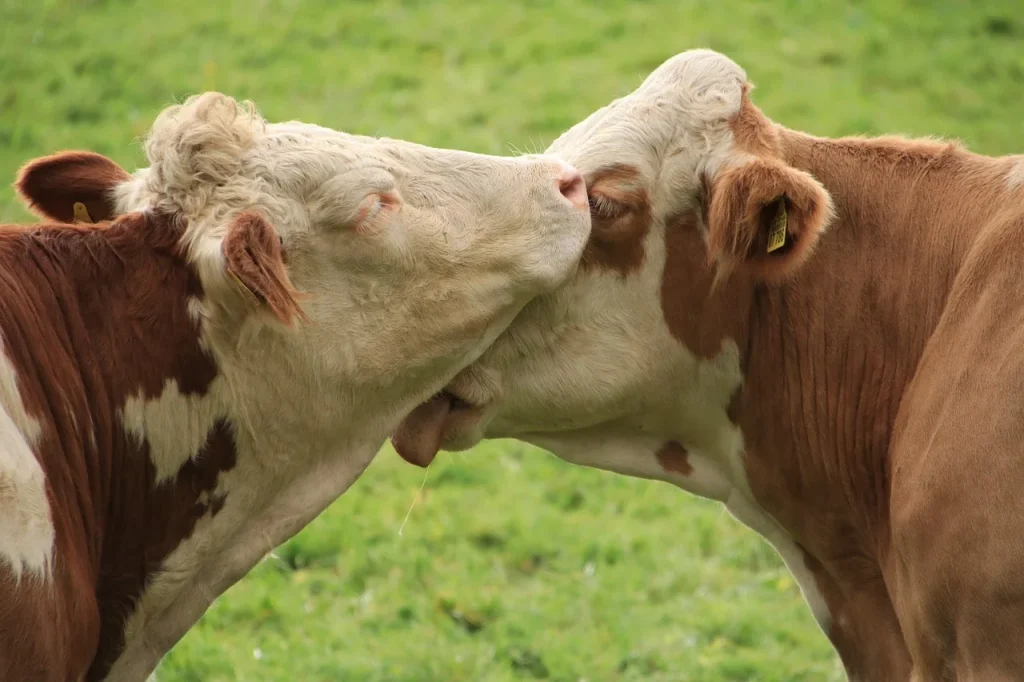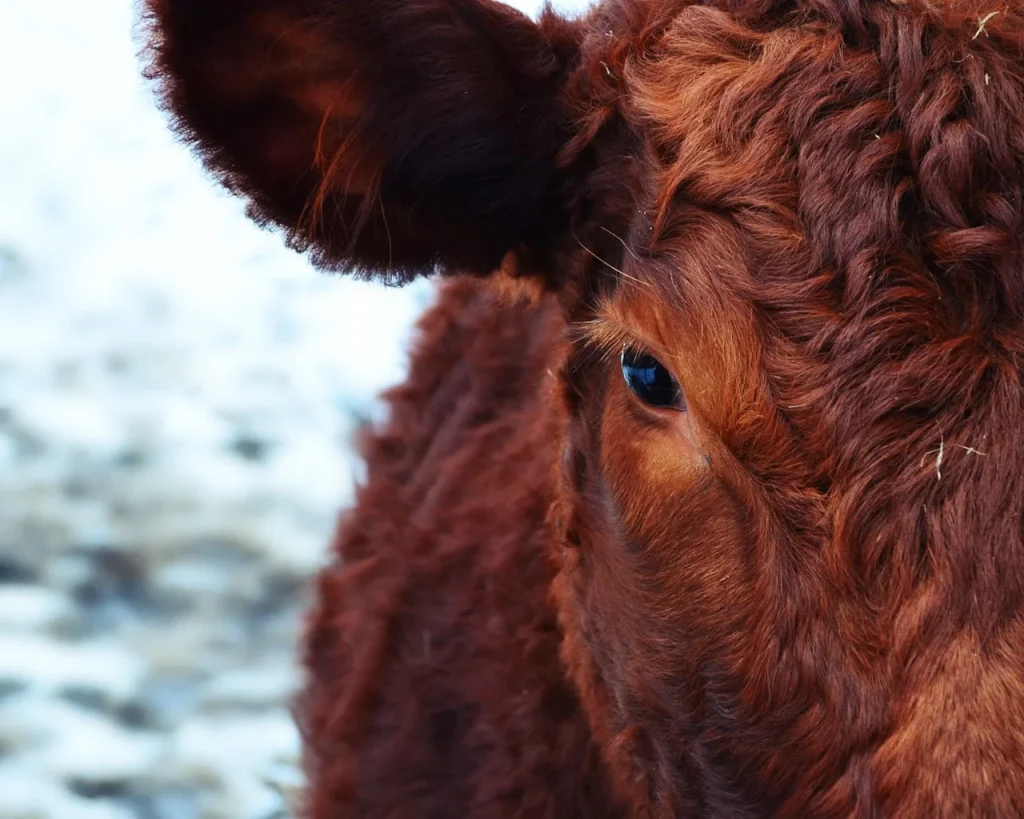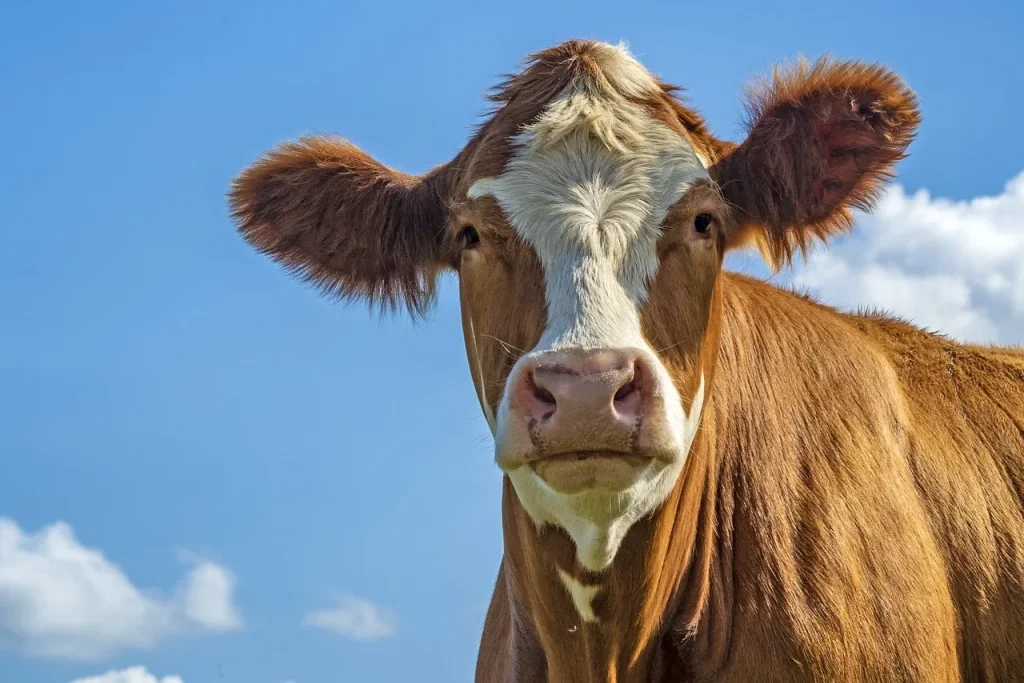Today, we’re setting off on a delightful discovery of the cow kingdom with some moo-rvelous facts that might just change the way you think about these farmyard friends.
Cows do much more than just provide milk; they are fascinating creatures with emotions, intelligence, and even a sense of community. Ever thought about what a cow might talk about if it could chat with us? Keep reading, and you might get closer to the answer!
The cow is of the bovine ilk; one end is moo, the other milk.
Ogden Nash
Cow Facts
Let’s start our journey into the fascinating world of cows. Keep your eyes peeled as you explore each fact, because there’s a quiz at the end of this article to test your bovine expertise.
- Certain breeds can detect smells up to six miles away.
- Their stomachs have four compartments, enabling a complex digestive process.
- The average heart rate is 60-70 beats per minute.
- They are known to produce over 200,000 glasses of milk in a lifetime.
- These animals have almost 360-degree panoramic vision.
- They can sleep while standing, but they dream only when lying down.
- Domestication occurred over 10,000 years ago in what is now Turkey.
- These creatures have a hierarchical social structure known as a pecking order.
- They can climb upstairs but have difficulty climbing back down.
- Johne’s disease, a condition similar to Crohn’s disease in humans, affects them.
- Their lifespan can reach up to 20 years under ideal conditions.
- The gestation period is about 283 days, close to that of a human.
- They contribute to grassland biodiversity by grazing unevenly and fostering different plant growth.

- Oxytocin release during milking improves their milk flow and indicates a positive emotional state.
- Calves begin grazing within a week of birth.
- Their body temperature is around 101.5°F (38.6°C), slightly higher than that of humans.
- Moos can be unique, with each individual having a distinct sound to communicate.
- A group of these animals is known as a herd.
- They can remember faces for several years.
- High emotional intelligence allows them to form strong bonds with their offspring.
- Individuals have been shown to bear grudges after negative experiences.
- They display signs of excitement and jump around when they solve problems.
- Belgium Blue is known for its extremely muscular appearance due to a genetic condition called double muscling.
- Their dung is essential for sustainable agriculture, as it returns valuable nutrients to the soil.
- Methane gas produced by them is a significant issue for climate change, leading to innovative diets designed to reduce emissions.
- The color red doesn’t provoke them; they are actually color-blind to red and green.
- India has more of these animals than any other country in the world.
- Eyelashes protect their eyes from dust and debris.

- Licking is a grooming behavior that also establishes social bonds within the herd.
- Ear tags are used not just for identification but also to monitor health and reproductive status.
- Low-frequency noises are used by mothers to communicate with their calves.
- A dairy cow drinks about 30-50 gallons of water per day.
- Artificial intelligence is now used to monitor their health and enhance milk production efficiency.
- The first cloned animal, Dolly, was a sheep, but cloning has since been successfully applied to cows, leading to genetically identical animals.
- They have an excellent sense of smell and can detect odors up to six miles away, which helps them locate water and identify predators.
- Switching tails is not just for swatting flies; it also communicates mood and social cues to other herd members.
- Their saliva helps neutralize stomach acid and aids in the digestion of fibrous materials.
- The Isle of Man has its own breed, the Manx Loaghtan, notable for its dark brown wool and multiple horns.

- They play a critical role in religious ceremonies and cultural festivals in many parts of the world.
- Holsteins are the most common dairy breed and are highly recognizable by their black and white spots.
- Leather from these animals is used in making a wide variety of products, including clothing, shoes, and accessories.
- Ruminating can take up to 10 hours a day, a vital part of their digestion process.
- A single cow can displace about 200 pounds of manure per day.
- They contribute to the dispersal of seeds through their manure, which helps propagate many plant species.
- During hot weather, they consume less and produce less milk, which is a significant challenge for dairy farmers.
- Yak milk is a staple in some cultures and is richer in fat and protein than typical cow milk.
- The famous “Laughing Cow” cheese logo is actually based on a breed called the French Simmental.
- Pedometers are used not just for step tracking but also to detect estrus and optimal times for artificial insemination.
- They often chew for up to 8 hours a day, grinding their food to ensure efficient digestion.
- Biogas from manure is an eco-friendly energy source, turning waste into power for farms.
Cow Myths

Now that we’ve covered some key facts, let’s tackle some common myths about cows. It’s important to distinguish fact from fiction, so we can appreciate these animals even more.
- Cows have four stomachs
They do not actually have four separate stomachs; rather, their stomach is divided into four distinct compartments. These include the rumen, reticulum, omasum, and abomasum, each playing a unique role in digesting tough plant materials. - Cows are not intelligent
Intelligence is often observed in cows, who have shown the ability to solve problems, remember tasks, and recognize different individuals. They are known for their problem-solving skills and social complexity. - Cows can only see in black and white
Contrary to this common belief, they have dichromatic vision, meaning they can see colors, though not as vividly as humans. They can distinguish between several colors, including blue and yellow. - All cows are female
It is often mistakenly believed that all of them are female. In fact, ‘cow’ specifically refers to female cattle that have had a calf. Male cattle are known as bulls or steers, depending on whether they are intact or castrated. - Cows contribute little to greenhouse gas emissions
They are significant contributors to greenhouse gas emissions, mainly through methane produced during digestion. Methane is a potent greenhouse gas, and the cattle industry is a notable source of this emission.
No products found.
Cow Quotes

Prepare to be surprised by the depth of emotions and observations these quotes reveal about our gentle giants. Feel free to share yours in the comments so I can add them to the list.
Cows are amongst the gentlest of breathing creatures; none show more passionate tenderness to their young when deprived of them.
Thomas de Quincey
Thomas de Quincey praises the inherent gentleness and strong maternal instincts of cows in his observations.
A cow’s heaven is a flower’s idea of hell.
Oliver Gaspirtz
In this quote, Oliver Gaspirtz offers a playful perspective on how a cow’s grazing might be seen as destructive from a flower’s point of view.
Sacred cows make the best hamburger.
Mark Twain
Mark Twain uses a metaphor to comment on the idea that no subject should be so revered that it cannot be criticized or challenged.
I never saw a purple cow, I never hope to see one; But I can tell you, anyhow, I’d rather see than be one.
Gelett Burgess
Gelett Burgess’s famous lines play with absurd imagery to express contentment with reality over fanciful or bizarre alternatives.
The cow is nothing but a machine which makes grass fit for us people to eat.
John McNulty
John McNulty offers a blunt and somewhat utilitarian view of cows, emphasizing their role in human agriculture and food production.
Cow FAQ

As we approach the final section before our quiz, pay close attention to these frequently asked questions. Your understanding here will be key to acing the upcoming trivia!
- Do all cows have horns?
Not all of them have horns. Both male and female cows can have horns, depending on the breed. However, many farmers choose to remove the horns for safety and management reasons. - Will cows eat apples?
Yes, they can eat apples! Apples are a tasty treat for cows, and they enjoy the sweetness. It’s important to feed them in moderation and to cut the apples into smaller pieces to prevent choking. - Are cows colorblind?
They are not completely colorblind, but their color vision is limited. They can see blues and yellows better than they can see reds and greens. This means their world appears somewhat differently from how humans see it. - Can cows eat clover?
Absolutely! They can eat clover, and they actually love it. Clover is nutritious and helps cows produce high-quality milk. However, it should be part of a balanced diet to prevent bloating. - Are cows sacred in India?
Yes, in India, they are considered sacred by many in the Hindu community, which makes up a significant part of the population. They are revered, protected, and cared for, and their wellbeing is culturally important.
No products found.
Cow Trivia

Welcome to the udderly entertaining cow quiz! Get ready to milk your brain for all it’s worth. If you don’t get any questions right, beware—you might just find yourself in a high steaks situation!
Cow Merch
If you are a true fan of cows, then you definitely need to check out our merchandise. You can find T-shirts, hoodies, mugs, and tote bags for your favorite designs. Feel free to check out all the other designs in our shop.
Conclusion
Cows are truly fascinating creatures, each with their own unique personalities and behaviors. From their incredible memory to their ability to navigate using magnetic fields, cows demonstrate intelligence and complexity.
It’s important to appreciate these gentle giants not just as providers of milk and meat, but as interesting animals who play a significant role in our ecosystems and agriculture. Remember, treating cows with kindness and respect benefits both the animals and the quality of products we obtain from them. Till next time, stay curious and explore more. Cheers.


